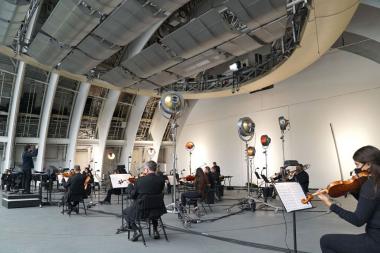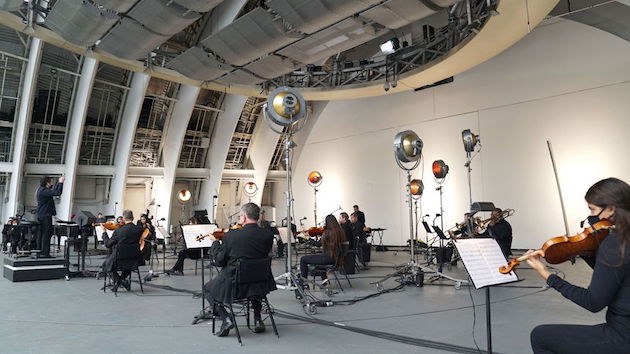
On July 14, Marc Sazer, one of Los Angeles’s premier studio musicians (president of the Recording Musicians Association and violinist with the Pasadena Symphony) went to work for the first time since the coronavirus pandemic shut down live recording sessions. But from the moment Sazer pulled his car onto to the lot at Twentieth Century Fox, it was clear the world had changed entirely.
For months, a consortium of studio and orchestra administrators, local unions, government officials, and infectious disease specialists had worked to establish a set of protocols that could establish a safe environment for musicians to perform in — whether on the studio soundstage or the stage of the Hollywood Bowl.
Ten pages in length and exceedingly detailed, the Reopening Protocol for Music, Television and Film Production: Appendix J went into effect on June 12, with modifications being added well into July, right up to the day Marc Sazer reported for work.
“When I arrived that morning,” Sazer recalled, “I’d already gotten a lot of paperwork telling me what I could expect, making it clear we would all have to wear masks the entire time we were indoors.”
There was at least one pleasant surprise.
“When I drove on the lot, I got a surprisingly good parking space,” he said.
But it didn’t take long for the challenges of the new reality to sink in.
“When I walked to the scoring stage there was a tent set up with a COVID officer and a nurse. One by one they took our temperatures and ran us through a healthcare questionnaire.”
The Reopening Protocol describes the duties of the COVID Officer:
A workplace COVID-19 Compliance Officer is responsible for establishing and enforcing COVID-19 safety protocols, training staff on protocols, and monitoring compliance. If feasible, experts with experience in infection control are consulted in creating and reviewing infection control protocols for new Music, Television, and Film productions, to revise established protocols, and generally provide consultation for the C19CO. The C19CO maintains, secures, and protects the privacy of any records created during their work. The C19CO should be on site whenever possible when production work is being performed, particularly during on-site or on- location filming.”
The specifics for social distancing are precisely defined by instrument type, with string players an average of six feet apart. No one plays with a stand partner. As the regulations state:
All cast and musicians performing work in which they cannot wear a face covering (e.g. actors, wind and brass instrument players, singers) should strive for a minimum of 8 feet of social distancing during rehearsal or performance. Alternatively, wind and brass instrument musicians should be separated from others and from each other by Plexiglas or other barriers.”

“We knew we weren’t going to have stand partners,” said Sazer. “Each musician was issued a number that indicated our individual music stand. I was number 21. When I found my stand, a book with my music was already in place. My call was entirely for strings. Winds and brass would be recorded separately.”
Sazer went on to explain that the usual union-defined break times were increased to allow the doors of the soundstage (which cannot be ventilated during recording) to be opened, with fans brought in to totally recirculate the air, and all the chairs and music stands disinfected.
“We weren’t allowed to eat or drink in the studio. And when we left for lunch all the chairs and stands were disinfected. It was difficult, especially with the issues of wearing masks while we played and being distanced from the other musicians. But in the end, I think everyone found the precautions very reassuring. That being said, everyone has different circumstances and comfort zones. If people choose not to perform, we have to respect their health priorities and sensibilities.”
The initial goal of heath protocols was to get the multimillion-dollar industry of soundtrack recording for film and television back on track. But, as Sazer points out, a certain amount of recording/performance has continued even during the shutdown. Musicians like Jon Batiste, whose band accompanies The Late Show With Stephen Colbert, continued to perform using in-home recording equipment. As did Sazer when he was offered work.
“All of us that were called at that time were recording from home,” he points out. “We were required to install our own equipment too, which was a substantial expense.”
Classical Music Finds a Home Under the Protocol Umbrella
A surprising side effect of the reopening protocols (in combination with previously negotiated contracts between the Electronic Media Association [EMA] and the American Federation of Musicians [AFM]) was that it provided an unexpected umbrella. Because they were exclusively (for the foreseeable future) involved with “Audiovisual Capture and Release,” the rules (and fee structure) that applied to for-profit studio recording musicians could now be applied to nonprofit musical institutions like the Los Angeles Philharmonic and the Los Angeles Chamber Orchestra transforming them all into “studio musicians.”
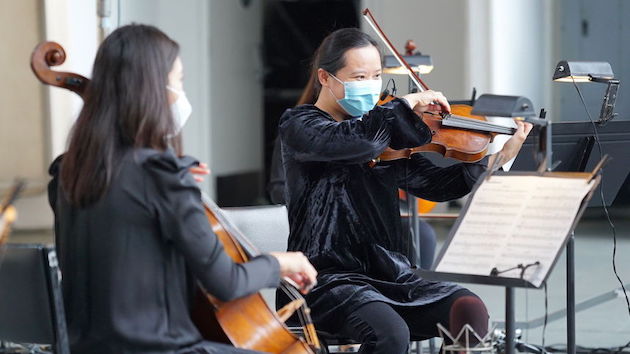
It is this designation that has allowed the Los Angeles Philharmonic to record two full orchestral programs (and their final rehearsals) on the vast stage of the Hollywood Bowl. Ideally suited to social distancing, these performances, conducted by Music Director Gustavo Dudamel, were recorded and will be streamed (possibly as pay-per-view) at a date to be announced. For these outdoor concert recordings, Dudamel is placed well-distanced from the players, not behind a barrier and not masked. The orchestra is in concert dress.
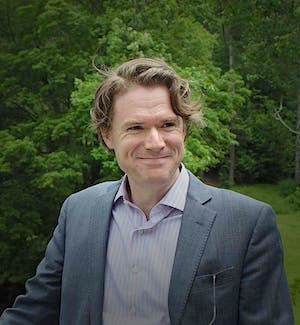
At the same time, the Los Angeles Chamber Orchestra has been producing a series of free livestream “SummerFest” concerts from the stage of the Colburn School’s Zipper Hall. And according to LACO’s new executive director, Ben Cadwallader, LACO intends to offer an expanded version of these free online concerts through July 2021.
The fly in the ointment is the Internet itself — a platform-turned-lifeboat for every arts organization desperate to connect with audiences and potential donors. The problem is that the entire vast menu of arts programming competes for attention from audiences who can consume everything from popular TV offerings to Zoom and FaceTime events.
The impact of the pandemic has been particularly hard on musicians, not just financially, but psychologically. Since childhood, their lives have been oriented to a process of practice, rehearsal, and performance that includes the response of a live audience.
When the COVID-19 shutdown was imposed, musicians suddenly found themselves with no performances to prepare for, no goals to work toward, none of the comradeship that comes with making music, and no audience response.
The only shining example of live classical music performance is San Diego’s Mainly Mozart. Since July 11, the organization has been presenting a series of bi-weekly, outdoor drive-in chamber music concerts with honking as the substitute for applause. The format has proved so successful and popular that Mainly Mozart is currently planning a pair of multi-day live festival performances to take place in September and October.
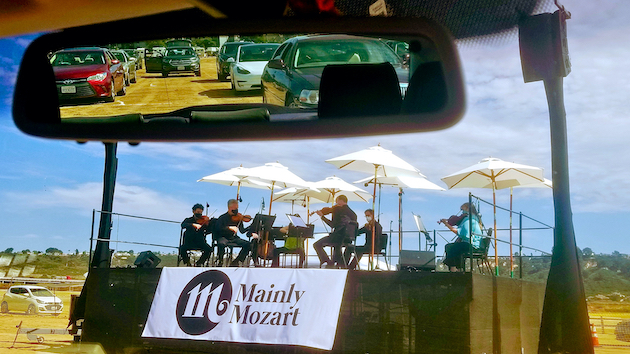
“This has certainly been the most difficult period of my career — as well as my colleagues’ — to have concert halls silent,” said Margaret Batjer, LACO’s concertmaster. “Since we were kids, we’ve been making music for other people. To have that taken away has felt like an assault. Realizing I was not going to be able to perform was devastating. Then LACO began reaching out and we did a series of 40-minute programs called LACO at Home. That led to our first group concerts at the Colburn School, our SummerFest.
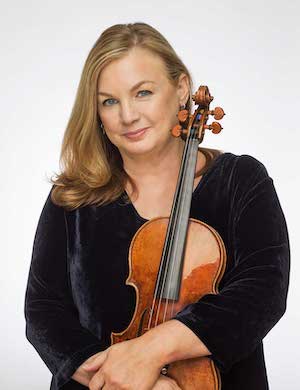
“It was a very long process,” Batjer explained. “LACO is a union orchestra and the American Federation of Musicians (AFM) began putting out some pretty firm guidelines, with the understanding that each local would tweak them based on the medical information available. Our local union had many discussions with our management and our orchestra committee, as well as the Colburn School [which operates Zipper Hall.] I was getting so many emails saying, ‘I want to play!’”
The problem, Cadwallader said, was that in the rush to get back to any form of live performance, crucial lines of communication were missed.
“We had originally planned for six free livestreamed summer concerts,” Cadwallader explained. “The plan was to start those concerts in mid-June. We followed all our regular hiring practices. We drafted safety protocols based on the CDC’s guidelines. We had all our ducks in a row. Then, as an afterthought, we said to the union’s orchestra committee how excited we were about these programs and what we were planning. We quickly realized we had gotten way ahead of ourselves, that the union was working with the studios on an agreed upon set of safety protocols. We had to slam on the brakes. Had we known those conversations were going on, we would have waited. Ultimately, once the studios and the union came to an agreement, we laid our procedures over theirs. But that experience represented the extent to which we are all doing our best to operate in an entirely new world.”
Making the Best of a Bad Situation
According to John Lofton, who plays bass trombone with the Los Angeles Philharmonic and is on the board of directors of Musicians Union Local 47, the orchestra’s pair of concerts at the Hollywood Bowl (as well as its recent recording sessions at 20th Century Studios for Steven Spielberg’s upcoming remake of West Side Story) illustrate the painful paradox of being a professional musician in the time of COVID-19.
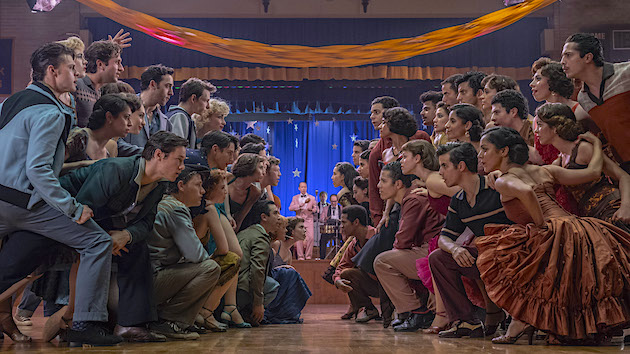
“You have to understand, the initial emphasis in LA was getting back in the recording studio, because that work was beginning to go out of town,” Lofton said. “We were fortunate because the protocols they conceived bled over into the type of performing that we do. The Philharmonic also did a lot of research with other orchestras that were trying to find ways to go back to work.”
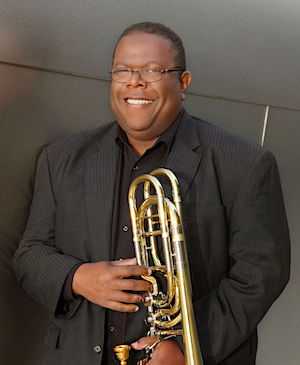
The question of social distancing, Lofton said, is a real issue, particularly for the winds and brass because of the instrument’s aerosol factor (flutes are the worst). The strings are positioned 6-feet apart (each at a separate stand). The winds and brass may be as much as 10-feet apart with many isolated behind Plexiglas enclosures, an unwanted side effect being the fractional echo effect that results when the sound bounces back.
“I can tell you, playing behind Plexiglas is not a fun thing,” Lofton observed. “All your training is about projecting. When you have the sound bouncing back in your face causing a vibration, it really affects your embouchure. You don’t know how much to compensate for it.”
In addition, the winds and brass players are equipped with an on-the-floor receptacle one musician described as a “kitty litter box” into which they have to spill the condensation from their instrument. Then they have to take the contents with them when they leave.
But the greatest frustration that the musicians I’ve talked to complain of is the social distancing and the lack of stand partners.
“Throughout your whole training,” Lofton observed, “you’re taught to be aware of what’s going on across the stage. Now, it’s exceedingly difficult to hit the downbeats together because there’s a distance delay. But then trombones are always accused of that,” he added with a laugh.
In its recent performances of Beethoven’s Seventh Symphony at the Bowl, several string players commented that trying to keep to the tempo during the rapid-fire third movement scherzo was almost impossible. The only consistent point of reference they had was Dudamel’s baton indications.
“It’s exhausting,” LA Phil concertmaster Martin Chalifour conceded.
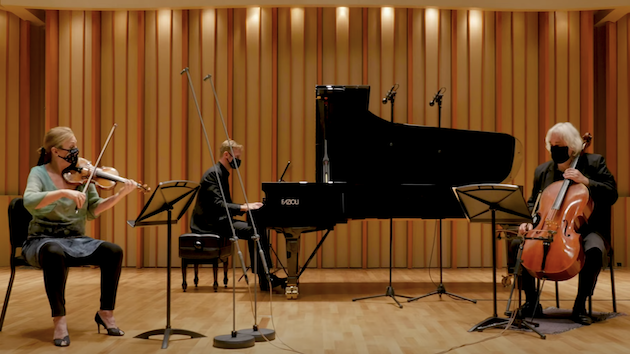
Give Me an “A”
“The bottom line is that musicians just want to play,” Lofton said. “It’s what we’ve trained all our lives for. All my colleague said how great it was to see one another and how emotional we felt when we heard that A to tune up for the first time after so many months.”
Margaret Batjer’s experience was similar the first time she and her fellow LACO musicians gathered on the stage at the Colburn School, with one sad caveat.
“The playing was wonderful, and the musicians poured their hearts out,” she said. “But when it ended and there was no audience to respond: The silence was deafening.”

